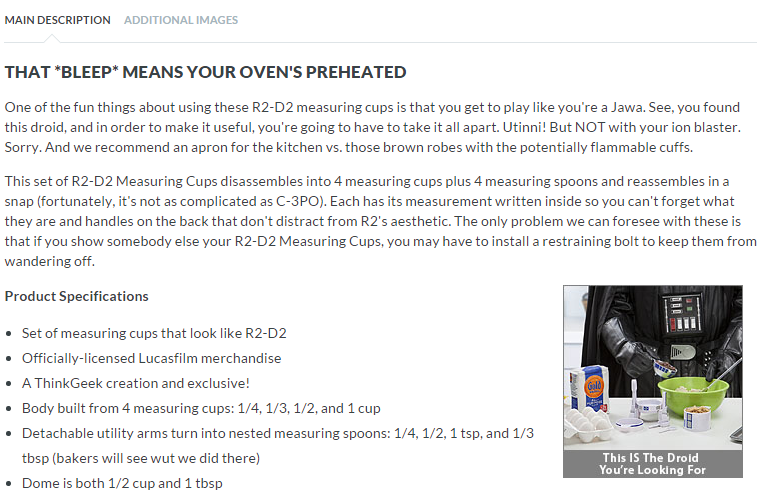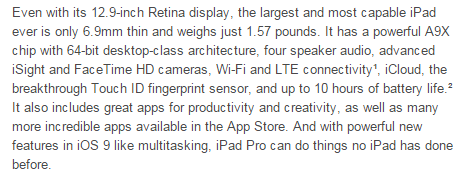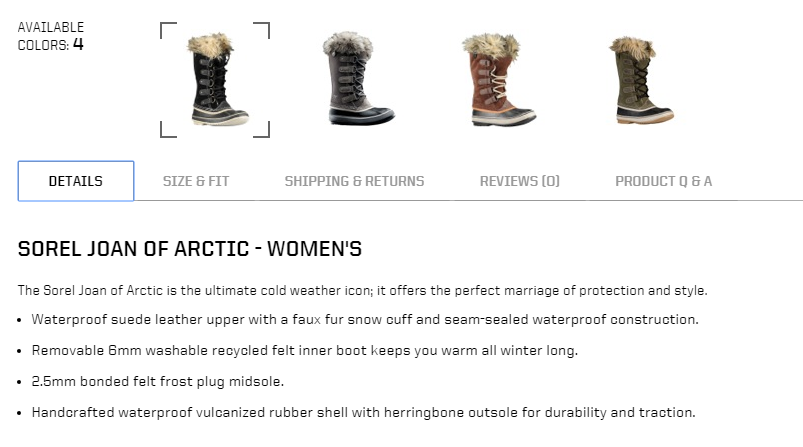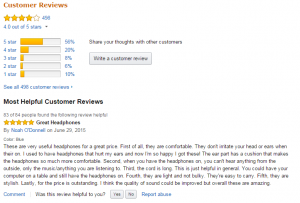10 Tips for Writing A Great Product Description

With Ebay, Etsy, Spreadshirt and many easily managed e-commerce software, selling on the internet is as easy as it has never been! You don’t need to be a big corporation with a warehouse as big as Amazons to benefit from offering your products to the online community. As a private person, you can sell self-made or items you don’t need anymore. As a small local shop, you can now reach a much broader audience.
But creating an account or setting up your own small online shop is not everything. Of course it is important to create an attractive landing page and to optimize your shop for SEO. What is overlooked way too often is that a remarkable product description is an important tool to entice customers and boost conversion as well!
Why A Good Product Description Is Crucial
The last thing a customer sees before either leaving the shop or clicking on the shopping card is the product page. Next to an attractive picture of the product, this page also contains the product description. As it is the last thing a customer sees before the potential conversion (aka the purchase), it plays a big role in persuading the customer to buy the product.

Oftentimes, the product descriptions are generic. They are provided by the manufacturing company or written by someone with no experience in writing for conversion. In these cases, the product descriptions are bland, boring, filled with technical details, unattractive. Plus, if you are looking for good SEO, you are in danger of duplicate content when using the description you got from your supply provider.
You don’t have to be a marketing expert to write a good product description though!
We from Online-Spellcheck.com can give you some tips on how a word-savvy and passionate writer can create a great product description as well!
Before You Start Writing
Before you start to write your product description, there are a few considerations for you to do up front. Just have a look at your product (literally or in your mind), and think about the following things:
1. The Ideal Buyer
Every shop and every product has a target group and thus an ideal buyer profile. This should be reflected in the product description. Writing with no specific buyer or a huge crowd of different buyers in mind will result in a description without rhyme or reason.
Instead, take the ideal buyer for a product and write the description specifically for him or her. Choose the right words and tone for them and answer the questions they are most likely to ask. Address the problems they may have and avoid words or formulations they may hate.
The easiest way is to imagine speaking to your ideal customer and transferring the matter of speech and the content into your written description.
If you are unsure about what the target audience of your product looks like, get in touch with the person responsible for marketing. Information like gender, age group, social class and interests can help you to imagine your ideal buyer.
To get more information about target audiences and online personas, we recommend reading this article from Forbes: The Key To Converting Customers
2. Find Your Tone of Voice
Your tone of voice is the character of your company converted into speech—or in this case into the written word. Adding your own tone of voice to your product description will serve several purposes at once: It addresses your target audience that should use the same jargon as you do, sets you apart from the competition and makes your company easily recognizable.
Besides, first time buyers will immediately get the right impression about your company’s culture and personality. Are you fun? Dry? Serious? Easy-going? Portrait it in your product description to make people relate to your brand and the product!
However, do not directly state how fun or competent you are. Let the content and the choice of tone and voice do this for you (and your organization). Instead of stating that your service is excellent, convey it with a friendly and approachable tone and understanding words.
To find your company’s tone, think of five adjectives that describes your culture and philosophy best. Also, do not forget to note down what you are absolutely not, for example rude, incompetent, or taciturn.
3. Features and Benefits
Before starting with your text, you should first figure out what to write about. A list of features for your product is necessary. With the help of such a bullet point list of technical details of your app or product, you can answer the questions your clients have.
How does your product improve their life? What problem does your product solve for them? How does the product make your customer feel? Will it ease daily tasks?
With such questions in mind, you can easily transform your list of features into a list of benefits your clients will experience once they own your product. Thus, when finished with this step you should have a list of benefits a customer can draw from your product and problems that can be avoided using it.
Another purpose such a list of benefit serves is to enable your customers to compare products more easily. If the set-up and layout of your online shop doesn’t already allow them to view products side by side, help them by keeping the description in a similar layout. This way, benefits and technical details can be compared more quickly than when your reader would have to pick information from different points in the texts.
Thus, make sure that crucial and distinguishing information is presented in a comparable way. This, for example, includes material, dimensions, requirements, size, color, volume, etc.
Writing The Product Description
With an image of your ideal buyer in mind and your own online persona’s voice in your ear, you can finally start producing content. Here are some tips on how to write a product description in a way that will entice your customers and lead to conversion.
4. Paint a Picture
With your pre-considerations sorted out, writing a first draft is easy. You know your voice and you know what your product can do for the potential buyer. Rank your list of benefits to bring them in a logical and easy to follow order.
Are there any problems a customer may have using your product? Address them as well and take the fears and doubts from your customer. If your product is rather pricey, describe the value your customer will get for the price. Does it seem difficult to use? Ease your customer’s mind by quickly explaining how facile the usage actually is.
Remember, this is your first draft. Whatever comes to your mind will go into this steps. Everything you want the customer to know about your product, all benefits and solutions to problems, as well as information about handling or any kind of justification is part of this first draft. Just write—and don’t worry too much about grammar, spelling, or style for now. We will get to that later.
For now, you just want to write everything off your chest and bring it in a cohesive order. One enticing and popular way to do this is by writing a “story”
5. Justify superlatives
You think that your product is the best, first, most advanced or most easiest to use? This may be, but stating such superlatives without explaining them will make your words sound empty and not very credible. Instead of just leaving them standing on their own, back up your usage of superlatives by listing the benefits your product provides that makes it the best in its field. Give a short description of easy usage or provide other facts that justify why your product is the best.

If you can not provide the information necessary to prove that your product is the most advanced then don’t state such a thing. Tone down your copy and use strong words without a superlative.
6. SEO
As an online business, there is one very important part you have to consider when writing a product description: Search Engine Optimization. Search engines will crawl your sales page just like any other page on the web, and the better your SEO, the higher it will rank in the search results for your keywords.
Thus, key phrases and keywords should be used as headlines or bolded in the text to call not only your customers’ but also the search engine’s attention. Pictures can also be optimized by using keywords in the file description and the alt tag.
However, do not—I repeat: not—sacrifice the readability of your text in favor of SEO! While SEO is important, your customers should always come first!
7. Less Focus on Dry Facts and Technical Details
We have talked a lot about painting a picture and writing a story for your customers, but what about the cold hard facts? They can not always be omitted, for sure, especially if the information is crucial for your customers.

The way many online shops handle this is by not displaying the technical details and hard facts together with the description. The description is displayed prominently as it is the tool to engage your customer. A link or tab that hints to “Details” or “Technical Specifications” hides the dry facts from the readers first glance.
However, do not hide the link to the details too well. They are still a crucial part of your product!
Review And Edit
Congratulation! Now, you have written down and noted everything that needs to be included in your product description. However, the job is not quite done yet. Before posting your product description or getting it print-ready, some fine-tuning is in order!
Next to correcting grammar and spelling, this step will make sure that your product description is not only informative but also enticing and readable.
8. Engage Your Customers
Re-read your whole description and the list of benefits to make sure you haven’t forgotten anything you wanted to say. Is this the case, then move on to make sure that the description is engaging your customers!
The voice of your online persona should already match the one of your target audience, but make also sure that you are using a language that is easily understandable. Using complicated and hard to understand words disgruntles a customer rather than entices him.
To engage your customers use emotional language. You want to speak them on a more than purely informative level. Terms that invoke feelings as well as sensory adjectives are the way to go. Use words that will make the reader feel. This can easily be done by thinking of the human senses. Include phrases that involve feeling, smelling and tasting, if possible.
However, even though we encourage you to use emotional language, do not waste your readers time. Get to the point with a short story instead of filling pages with repetitive or empty phrases. Thus, make sure that every sentence you write contains information valuable for your readers without repeating yourself. Generic statements like “Exceptional product quality” should be avoided as well. It will just make your customer think “Yeah, they all say that”. Instead, present them with facts. This will make you more credible and will build more trust between you and your customer.
The product description is written for your customers and with your customers in mind. Thus, make sure that the focus is on the buyer and their gain and not your company. Use the word “you” more often than the brand or product name. Put yourself in your customers’ shoes. Would you buy the product? Do not stop or be satisfied with anything until you know that your copy can persuade your customers to buy your product.
9. Readability
Of what use is a great and elaborate product description if nobody will really read through it? Make sure that your product description is easily scannable and readable for your customers. There are a few easy formatting and styling tips that will create your content into one that is easier to read.
- Headlines & subheadings: separate important sections, should be enticing, focus on a benefit of the product or a problem it erases
- Font size: bigger than in a continuous text, e.g. headings with 25 px, content with 16 px
- Font color: vary in color for headlines, bullet points, etc.
- White space: leave enough white space between paragraphs, bullet points, etc.
Of course this doesn’t mean that you shouldn’t add any continuous text! It’s the mix that loosens up a strict and boring layout and makes it much easier and fun to read. In a running text, try to keep the sentences short and easy. Images of your product as well as people using it add to the visual appeal as well. If you have images or even a video: us, embed and show off!
10. Customer Reactions

Many online shops provide the feature of rating products. There are benefits and risks for this, however we will not engage in this topic. Instead, we are encouraging you to use positive feedback about a product in your product description.
Has your product been featured on a website or in a magazine? Then mention it (best with a picture attached). Did you receive positive feedback from users on Facebook or Twitter? Then use their tweet or message to show the appreciation for a certain product. Do you have proof from the sales department that one article is selling exceptionally well? Get a statement about this from a person on the team.
Expressions like “best-selling”, “press favorite” or “popular gift” describe the product as popular. A name attached to a quote of a positive review makes it more credible, and a picture of the person added makes your company more approachable as well. Always make sure to ask whether it’s okay to use an image of a fan on Twitter or Facebook though!
